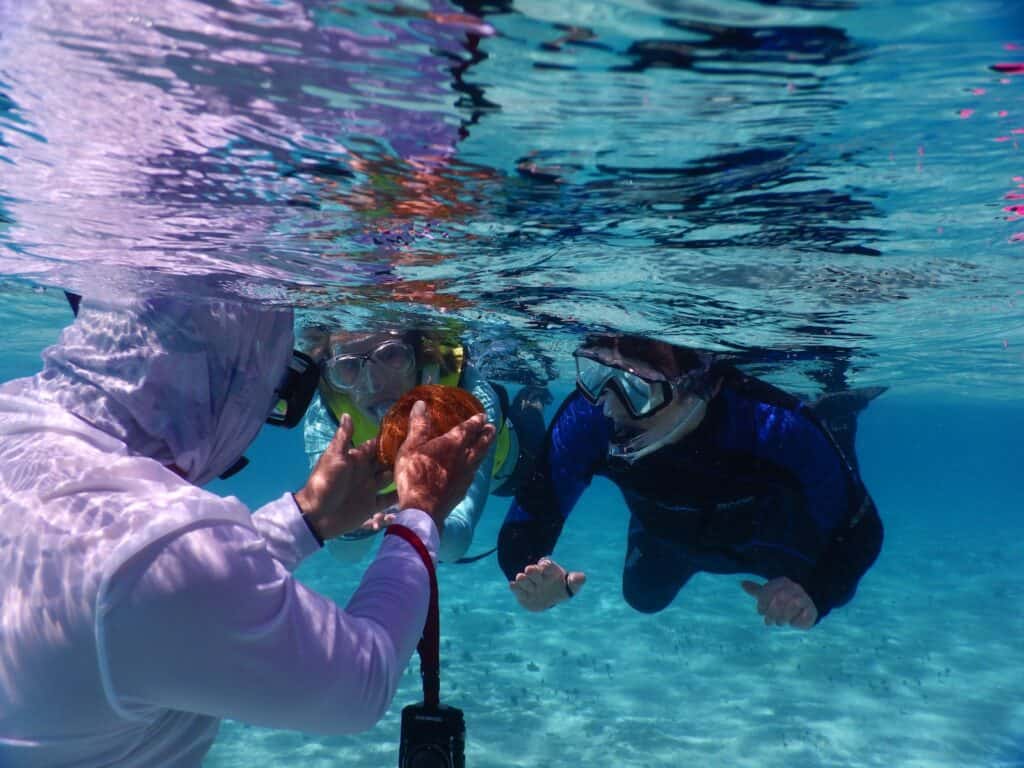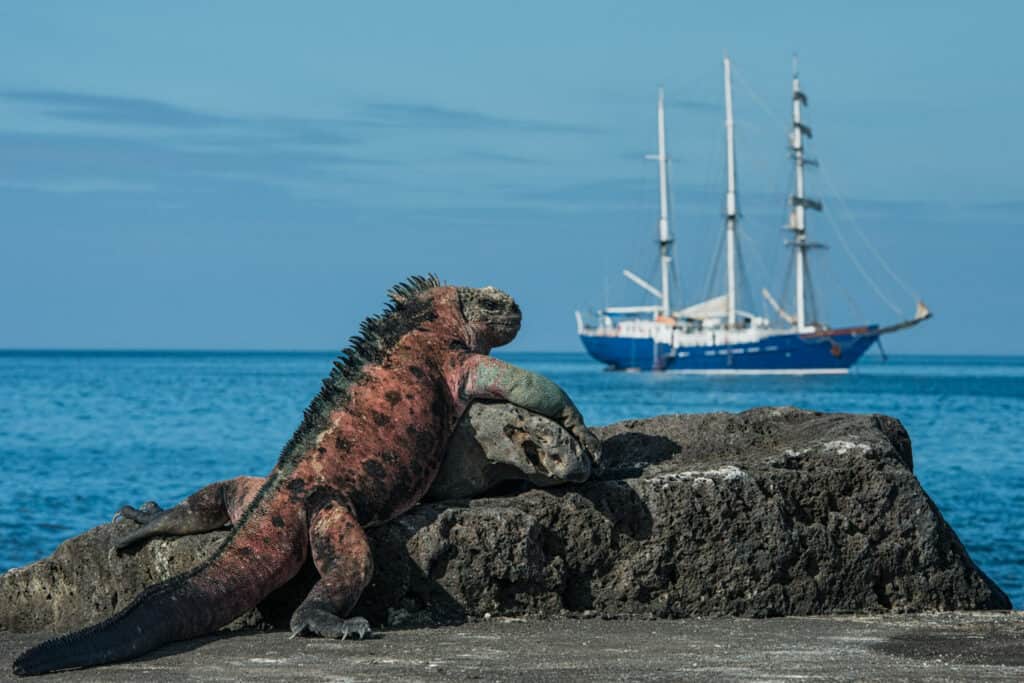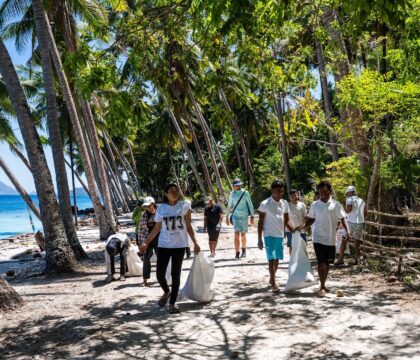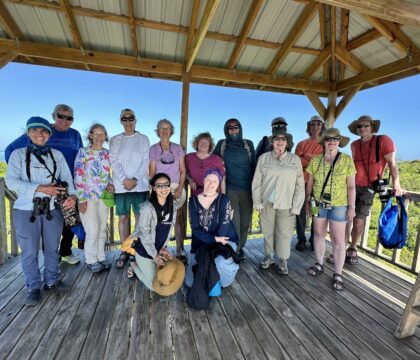November 4, 2025 • Travel Ideas
Imagine standing on a moonlit beach as a leatherback sea turtle lays her eggs, or watching a gray whale mother gently guide her newborn calf through the water, and knowing that your presence is helping protect them for generations to come. Every Oceanic Society expedition is designed to foster these transformative connections between travelers and wildlife, while directly supporting conservation programs that help these species thrive.
According to the International Union for Conservation of Nature (IUCN), 28 percent of all known species are threatened with extinction, largely due to habitat loss and unsustainable human activity. In many coastal regions, wildlife once viewed as a resource to be harvested (whales, sea turtles, coral reef fish) has become a source of pride and prosperity through responsible tourism. By creating jobs in guiding, hospitality, and conservation, sustainable travel offers an alternative to extractive industries like fishing, poaching, and mining. When communities benefit from protecting nature rather than exploiting it, both people and wildlife can thrive for the long term.
This principle is at the heart of Oceanic Society’s sustainable travel model. Our expeditions support local businesses and community leaders who are committed to conservation, ensuring that tourism directly supports livelihoods tied to healthy oceans. Travelers gain rare opportunities to engage with frontline conservationists and researchers protecting endangered wildlife, and see firsthand how their participation contributes to lasting change.
Below are some of Oceanic Society’s best trips for travelers seeking meaningful, conservation-focused experiences around the world.
Protect Leatherback Sea Turtles on Trinidad’s Beaches
With roughly 20,000 nests laid each year, Trinidad is home to the world’s densest leatherback sea turtle rookery. On moonlit nights at Matura Beach, dozens of massive leatherbacks, some weighing over 1,000 pounds, emerge from the waves to nest, continuing an ancient ritual that has unfolded for millennia. This awe-inspiring wildlife spectacle draws eco-tourists and volunteers from around the world to witness and help protect one of nature’s most extraordinary events.

On the shores of Trinidad, one of the world’s key leatherback nesting grounds, a team of Oceanic Society volunteers shares a moment of triumph with a leatherback turtle after her nesting. © Ben J. Hicks
The Turnaround Story
Just 40 years ago, it was poachers, not travelers, who patrolled the beach to harvest leatherback meat and eggs for profit. The slaughter pushed this population of leatherbacks to the brink of extinction. But an inspired local, Suzan Lakhan-Baptiste, changed all that. Witnessing this devastation firsthand, Suzan vowed to dedicate her life to saving the leatherbacks. What began as a small group of concerned citizens walking the beaches at night to deter poachers and raise awareness grew into Nature Seekers, a grassroots organization that has since helped to transform the local economy from one built on exploitation to one centered on conservation and sustainable ecotourism.
How You Can Help
Partnering with Nature Seekers, Oceanic Society offers a sea turtle volunteer trip to Matura Beach, Trinidad, that reinforces this groundbreaking conservation effort. Travelers don’t need to have a scientific background, just an eagerness to contribute to meaningful conservation, protect wildlife, and be part of lasting change.
On this volunteer vacation, travelers will:
- Learn about leatherback sea turtles’ nesting habits, life cycle, and the challenges they face
- Patrol sandy shores at night to spot nesting turtles with fellow volunteers
- Help local researchers measure, tag, and monitor nesting leatherback sea turtles each night.
- Travelers will also visit the beautiful Caroni Swamp, a 12,000-acre wetland that hosts mangrove forests, Scarlet Ibis, American Flamingos, silky anteaters, and more.
Curious what a volunteer experience in Trinidad is like? Discover Cindy and Bosley’s firsthand experience protecting nesting leatherbacks with Nature Seekers on Matura Beach. Read Their Story →
Swim with Endangered Manatees in Belize
Caribbean coastal development, including sprawling resorts, dredging, and pollution from urban expansion, has decimated seagrass beds, the primary food source and habitat for gentle giants like the Antillean manatee. These underwater meadows also stabilize shorelines and nurture diverse marine life. Their widespread loss fragments ecosystems and forces manatees into riskier, more exposed waters, amplifying dangers like boat collisions and starvation.
Why Belize Matters
Yet Belize’s St. George’s Caye remains a thriving refuge: a mosaic of seagrass meadows, coral reefs, and mangroves sheltering manatees, sea turtles, and more. This intact ecosystem is a hotspot for studying threatened marine life. Scientists here track populations to push for stronger protections. But, as is often the case, their data collection efforts need extra hands (and eyes) to cover more ground. This makes Belize an ideal destination for travelers eager to volunteer with marine life, offering the chance to contribute to ocean conservation while exploring vibrant marine habitats.

Vulnerable yet resilient, Belize’s Antillean manatees benefit from conservation efforts like Oceanic Society’s Belize snorkeling trips and Ocean Wildlife Volunteer program, during which you’ll snorkel alongside them, conduct citizen science surveys for population health, and support reef monitoring in this Caribbean biodiversity haven.
Take an Ocean Wildlife Volunteer Trip
Oceanic Society partners with conservation researchers in St. George’s Caye to offer a special wildlife volunteer trip in the heart of one of the Caribbean’s last intact ecosystems. Volunteers will:
- Learn how to monitor and document wildlife, generating data used to advocate for greater marine protections within the region
- Assist local scientists in collecting data on manatees, sea turtles, and dolphins through boat-based surveys.
The work is simple but important: snorkel through Belize’s waters and record sightings of various marine species. Travelers don’t need a background in data collection to support this work, just a willingness to help endangered animals as they travel. Every tally counts in the support for wildlife conservation. It’s a low-key adventure with high-impact results, perfect for travelers craving meaningful Belize wildlife tours.
Visit the Famously Friendly Gray Whales of Baja California
In Mexico’s Baja California, gray whales, once hunted to near extinction, now seek out humans in a touching display of trust. Mothers guide curious calves alongside boats in San Ignacio Lagoon, seemingly inviting gentle human touch that leaves visitors deeply moved.
From Whaling Grounds to Whale Haven
Once deemed the “devil fish” due to the ferocity with which mothers would protect their calves, gray whales were slaughtered here until whaling bans and government protections took hold. Today, the same lagoon has transformed into a whale watching sanctuary where ecotourism fuels the local economy.
This extraordinary interaction happens nowhere else in the world. Brushing one’s fingers across the back of a gray whale is an emotional experience—one that brings many travelers to tears. This experience is made even more remarkable given the lagoon’s dark history. As gray whale mothers bring their calves to introduce them to humans in the warm lagoon waters, many speculate whether this is some sort of cultural ritual, passed along from generation to generation of whales, as they make peace with the species that nearly drove them to extinction.

Join the Legacy of Protection
Today, visitors to San Ignacio Lagoon can actively partake in this remarkable story while supporting a local economy that protects, rather than exploits, these incredible animals. On this unique Baja whale watching expedition, you’ll combine unforgettable gray whale encounters with exploration of one of the world’s most diverse marine ecosystems.
- Spend two full days watching and interacting with gray whales, including cow-calf pairs and courting males, in this UNESCO World Heritage Site.
- Support nearly three decades of sustainable whale tourism in Baja, directly contributing to local conservation and economic development.
- Venture to the Sea of Cortez to spot the largest animal on the planet, the blue whale, as well as fin, humpback, sperm whales, and dolphins.
Safeguard Endemic Wildlife in the Galápagos Islands
Mariners from around the world once poached animals from the Galápagos Islands indiscriminately and introduced invasive species, pushing several endemic animals, like the iconic giant tortoise, to the brink of extinction. Today, these islands are among the world’s most legendary ecotourism destinations, and visitors who travel responsibly help fund local conservation efforts with a proven track record of protecting endangered species.

A Galapagos giant tortoise ambles across lush grasslands in the islands’ highlands, observed closely by travelers during a wildlife-focused cruise.
Support Giant Tortoises
Galápagos giant tortoises have rebounded thanks to decades of breeding and reintroduction efforts led by local conservation groups, like the Charles Darwin Research Station. Visitors to this center not only witness these incredible creatures roam the lush highlands, but their visits directly help the organization spearheading their recovery.
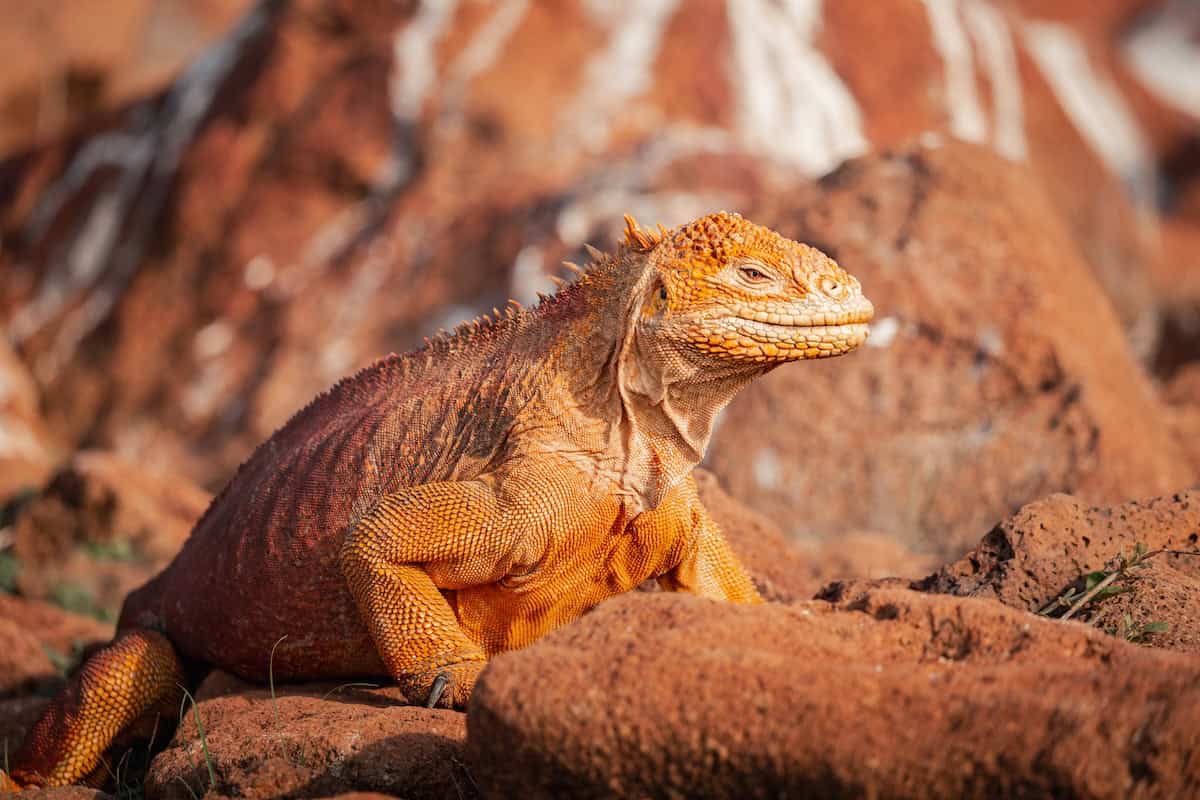
On the sun-baked shores of North Seymour Island in the Galapagos, a striking male Galápagos land iguana—known for its vivid orange hue during mating season—lounges alertly on the rocks, surveying its domain.
Protect Galápagos Land Iguanas
Once abundant, Galápagos land iguanas were nearly wiped out by invasive predators, such as rats, which prey on their eggs. Conservation programs, funded in part through ecotourism, have helped populations rebound, particularly on North Seymour Island, where the population is slowly growing.
Encounter Unique and Vulnerable Wildlife
Many of the Galápagos’ iconic animals are found nowhere else, and are uniquely vulnerable to invasive species, climate change, and human behavior. An expedition to the Galápagos Islands with Oceanic Society gives travelers a chance to support wildlife conservation programs directly while observing these extraordinary species in their natural habitat.
On an Oceanic Society Galápagos cruise, you can:
- Observe giant tortoises and land iguanas in protected areas and highlands.
- See marine iguanas, Galápagos penguins, and Blue-footed Boobies thriving in their natural ecosystems.
- Learn about ongoing invasive species management and reintroduction efforts from expert naturalists.
- Visit the Charles Darwin Research Station, learning about conservation and recovery programs for giant tortoises, land iguanas, marine iguanas, and other endemic species.
- Contribute to a growing ecotourism-based conservation economy that ensures these endemic species survive for future generations.
Volunteer at the Shark Sanctuary in Palau
Sharks play a crucial role in balancing marine ecosystems, but across much of the world, shark populations have been devastated by overfishing. Palau, however, has emerged as a global leader in shark conservation, and the government has leveraged ecotourism to protect these creatures.
Palau’s Bold Legacy
In 2001, Palau established the world’s first shark sanctuary, making this small nation in the South Pacific a global leader in marine conservation. By 2014, Palau had banned commercial fishing throughout its waters, establishing the entire country as a “100 percent marine sanctuary.” A key reason driving this decision was a study that found that a live shark in Palau is worth $1.9 million in tourism revenue throughout its lifetime, while being worth just a few hundred dollars when killed and sold to market.

Amid the biodiverse reefs of Palau—the world’s first shark sanctuary—blacktip reef sharks navigate the vibrant blue depths. © Fish-n-Fins
Palau Shark and Coral Reef Volunteer Expedition
Today, Palau has one of the healthiest shark populations in the world, and its coral reefs, including those within the legendary Rock Islands, are flourishing. For travelers looking to visit Palau and make an extra impact, join a hands-on scuba diving and snorkeling expedition to survey shark populations and coral reef health in the world’s sixth-largest marine sanctuary. Volunteers work alongside the Micronesian Shark Foundation and local partners to monitor shark populations, contribute to reef research, and help safeguard one of the most biodiverse marine regions in the world.
Scuba dive or snorkel in Palau’s tropical waters, within the world’s first shark sanctuary, home to some of the highest shark abundance and species diversity in the Pacific.
- Support marine research by collecting data on coral reef health and fish biodiversity in areas with varying shark populations.
- Participate in a long-term citizen science project focused on identifying and monitoring shark species to better understand their role in reef ecosystems
How Your Travel Supports Conservation Beyond the Trip
Ecotourism can play a critical role in reshaping local economies to protect rather than exploit the natural environment. In many regions, it provides communities that might otherwise rely on logging, commercial fishing, or other resource extraction, with a viable livelihood that supports their families. By choosing an ethical ecotourism operator, travelers directly contribute to this important transformation.
The impact goes beyond economics. Studies show that immersing yourself in nature can fundamentally change how you see the world, fostering a deeper care for the environment and a lasting commitment to conservation.
At Oceanic Society, we aim to harness this potential and build a global grassroots movement for ocean conservation through our expeditions and our volunteer trips. Our team has been leading ecotours to the world’s most incredible and wild destinations for over 55 years, and we hope to see you on our future expeditions.
Zach Theiler
Join our community.
Latest Posts
Download Oceanic Society's Free Expedition Catalog
Get a free copy of our Expeditions Catalog by email or mail (in the U.S.) and start planning your next adventure!


